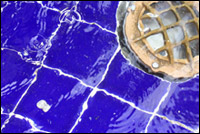Dear Umbra,
As part of my water-conservation strategy, I’d like to reuse the rinse water from my laundry machine to water the native plants, many of them edible, in my yard. I’ve heard concerns about the soap (biodegradable) damaging the plants. There are also potentially some regulatory hurdles involved. Can you shed some light on this?
Thanks,
Wendy
Gray All the Way
Seattle, Wash.
Dearest Gray All the Way,
Congratulations on having a water-conservation strategy. All praise to those with a plan, and all praise to gray-water recycling.
Gray water, other dear readers, is all the wastewater from your home excepting the toilet wastewater. The sink, shower, tub, dishwasher, and clothes washer are all gray-water sources. With a little filtering, this precious resource can be used on the landscape and returned to the water cycle without entering the public sewer first. I am not going to discuss bringing it back into the home today; that’s a whole other bucket of worms.

Could this drain lead to the garden?
Photo: Justin Ficklin.
Gray-water “contaminants” range from food waste to soap residue to dead skin. These are mainly great nutrients for plants, especially when filtered through mulch, but you will need to filter or eliminate the non-great ones. Soap and detergent ingredients to avoid are sodium, chlorine, and boron (which is, alas, a major ingredient in the handy cleanser Borax). These are either immediately harmful to plants or will become so over time, as they accumulate in the soil. Hence, you’ll need to avoid cleaning products that contain them, or install a diverter valve in your system so that when you use any of these harmful products, the water will run into the sewer system, not into your yard.
Gray-water systems basically involve adjusting your plumbing so that water travels through a filtration system and into your yard or a holding tank, instead of into the sewer pipe. The more drain contaminants, the more filtering you need, in the form of screens, plants, rocks, mulch, and the like. Every source I’ve read recommends starting a gray-water project with the easiest drains — the bathroom sink and tub, with their skin, hair, and soap flotsam — then moving on to the more contaminated drain of the clothes washer (lint!), and finally to the kitchen-sink water, which will be filled with grease.
Gotta pass the buck on regulations. These vary across the country and around the world, so to get specifics, please contact your health and building-code authorities. However, there are ways to collect gray water that don’t alter a building’s plumbing or involve the building code. Hauling buckets of water from the tub or clothes-washer drainage sink or hooking up a hose and siphon to your cooled-down bathwater are legitimate methods, and quite handy for renters. Your plan to divert the washer water could be a bit more complicated, but if it currently drains into a sink you won’t need to divert the house’s sewage drain pipe.
I’ll go into specific systems in the future, because I heart gray water right now, but the widely accepted resource is Create an Oasis with Greywater, by Art Ludwig. The corresponding website is extensive, too. Happy plumbing.
Pipely,
Umbra


